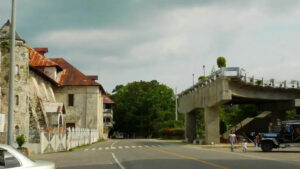It was more than a personal embarrassment for us at the Bangko Sentral ng Pilipinas (BSP) to host the governor of the Bank of Thailand and his staff over two decades ago, only for them to discover what many in Bohol had dubbed the “bridge to nowhere.” On social media, it’s called the “monument to stupidity,” while historian Ambeth Ocampo named it “bridge of folly.” Or simply, the “stupid bridge.”
At first, our Thai guests were captivated. The Loboc River cruise, with its indulgent buffet, showcased lush tropical vegetation and the exceptional Loboc Children’s Choir. The Busay waterfalls offered an almost endless feast for the senses. But enchantment turned to disbelief when we reached the infamous bridge — a concrete span over the Loboc River that abruptly ended before the centuries-old San Pedro Apostol Parish Church.
The church, of course, is not to blame. Built in 1602, replaced 35 years later, under the stewardship of the Jesuits and Recollects, the Loboc Church is the second oldest in Bohol, next only to Baclayon. It is both a National Historical Landmark and a National Cultural Treasure. Had the Department of Public Works and Highways (DPWH) persisted with its plans, the bridge would have desecrated the church, obliterated the plaza, and severed the bell tower.
Fortunately, a public outcry halted the travesty. Unfortunately, not before public funds had been wasted on an incomplete, purposeless structure. Today, it stands as a grotesque promenade — a visual testament to waste and corruption.
What distinguishes this stupid bridge from the flood control projects now under scrutiny is that the bridge, at least, exists. It’s a visible scar. The flood control projects, on the other hand, are in a league of their own — sui generis. Some exist but are poorly planned and executed; others don’t exist at all.
Last week, Senator Ping Lacson laid bare the scale of this rot.
From 2011 to 2025, roughly P1.9 trillion, or P127 billion a year, was poured into flood control. In the last three years alone, over P1 trillion. Yet reports show that flooding has worsened in many areas. Some blame climate change, and that’s not untrue. Warmer temperatures mean heavier rainfall; sea levels are rising. But even without typhoons or monsoons, these projects have failed to deliver.
Instead, we see the fruits of greed: luxury cars, multiple SUVs, even yachts and helicopters — symbols of plunder purchased with taxpayers’ money.
It’s no wonder Lacson ended his exposé with this stinging observation: “More than flood control, what the Filipino people badly need to see is greed control.”
Let’s do the math. After deducting VAT (5%), withholding tax (2%), bonds and insurance (1%), and materials testing (1%), contractors keep about 8-10% profit. This should leave enough for quality infrastructure.
But corruption takes a heavier toll. In Lacson’s “corruptionary,” the budget is carved up like lechon. The DPWH reportedly gets 8-10% — with district engineers pocketing up to 6%. Contractors grant reseta (excess profits) of 2-3% also to district engineers; the Bids and Awards Committee, 5-6%; and the Commission on Audit (CoA), 0.5-1%. Then there’s the “parking fee” or “royalty” of 5-6% for the sponsoring politician. And, most significantly, 20-25% goes to the “funder” — again, the politician.
What’s left for actual project implementation? Often just 40% of the allocated funds. No wonder flood defenses crumble.
Even worse, some politicians are also contractors. This dual role allows them to rake in both the contractor’s profit and the funder’s share — up to 35% combined. If it’s a project in their own district, add another 5-6% in “royalty.”
That’s over 40% for themselves. For a P100-million project, this means P40 million in their pocket.
Senator Lacson could have added that politicians cover their tracks well. Politicians can sponsor each other’s district projects, minimizing traceability. Even when project descriptions are identical — same costs, same scope — they are labeled “distinct.” This is so, so the politicians can claim: “akin ito” (this is mine).
President Ferdinand “Bongbong” Marcos, Jr. has all the reasons to be disappointed and angry. In Barangay Piel, Baliwag, Bulacan, a P55.7-million flood control project exists only on paper. No work was ever done — zero progress from February to October 2025 — yet the project was fully paid for, complete with receipts. Worse, flooding persists right where the supposed flood protection was built.
This is Bulacan’s second major flood control fiasco. In Calumpit, a dike — costing P96.4 million — broke barely three years after completion. Both cases reek of corruption and incompetence. The President’s threat to charge Syms Construction Trading with economic sabotage is warranted. But accountability must extend to DPWH officials, the Bids and Awards Committee, CoA, and the politicians involved.
To Marcos’ credit, P60 billion in infrastructure funds from the proposed 2025 national budget have been frozen due to inconsistencies with the Philippine Development Plan 2023–2028. Many of these projects were congressional insertions. In fact, 6,021 flood control projects since 2022 have suffered from technical deficiencies. Alarmingly, many cost exactly P150 million — a clear red flag for collusion.
Unsurprisingly, Bulacan tops the list for anomalous projects. A few DPWH district engineers have gained infamy for their avarice. Oriental Mindoro isn’t far behind; a congressman was reported to have funded projects with unprogrammed funds and claimed them as personal achievements.
How did all of this escape the scrutiny of the DPWH, the Department of Budget and Management, Malacañang, Congress, the Bids and Awards Committee, and CoA?
To place this in context, a 2022 study by Richard Martin E. Rinen and Norio Maki titled “Flood Control Projects in the Philippines: A Historical Overview” offers perspective. Published in MUHON: A Journal of Architecture, Landscape and the Designed Environment, the paper chronicles the Philippines’ long history of grappling with floods.
Flooding, the authors argue, is a natural consequence of living near bodies of water. Historically, communities used risk avoidance strategies — building on higher ground, designing structures to withstand water, and planning towns accordingly. These were low-cost, high-ingenuity approaches.
But over time, priorities shifted toward risk reduction — expensive structural solutions like dams, levees, and floodways. These require significant capital and long-term maintenance, both fertile ground for rent-seeking.
Today, without political will or good governance, even relocating informal settlers becomes politically fraught. Meanwhile, structural approaches open the door to corruption. It’s a cycle where incompetence and greed work hand-in-hand to subvert public goods.
They can result in a stupid bridge, or no bridge at all.
Diwa C. Guinigundo is the former deputy governor for the Monetary and Economics Sector, the Bangko Sentral ng Pilipinas (BSP). He served the BSP for 41 years. In 2001-2003, he was alternate executive director at the International Monetary Fund in Washington, DC. He is the senior pastor of the Fullness of Christ International Ministries in Mandaluyong.

